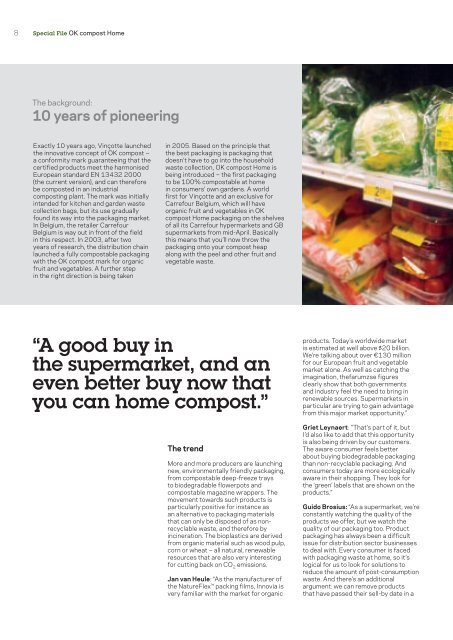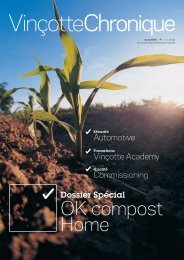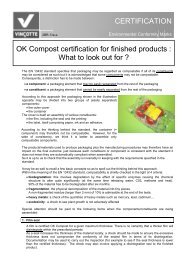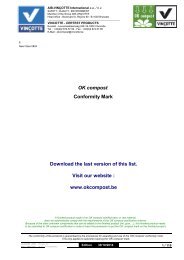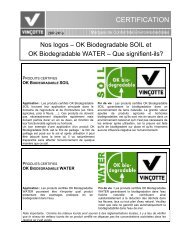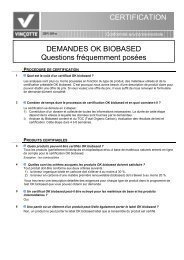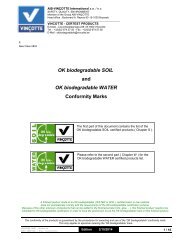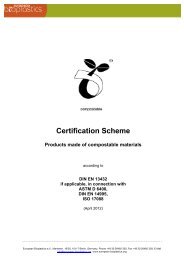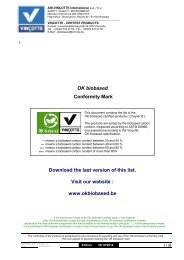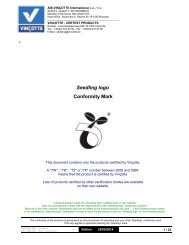vincotte kroniek GB.indd - OK compost
vincotte kroniek GB.indd - OK compost
vincotte kroniek GB.indd - OK compost
Create successful ePaper yourself
Turn your PDF publications into a flip-book with our unique Google optimized e-Paper software.
8<br />
Special File <strong>OK</strong> <strong>compost</strong> Home<br />
The background:<br />
10 years of pioneering<br />
Exactly 10 years ago, Vinçotte launched<br />
the innovative concept of <strong>OK</strong> <strong>compost</strong> –<br />
a conformity mark guaranteeing that the<br />
certified products meet the harmonised<br />
European standard EN 13432 2000<br />
(the current version), and can therefore<br />
be <strong>compost</strong>ed in an industrial<br />
<strong>compost</strong>ing plant. The mark was initially<br />
intended for kitchen and garden waste<br />
collection bags, but its use gradually<br />
found its way into the packaging market.<br />
In Belgium, the retailer Carrefour<br />
Belgium is way out in front of the field<br />
in this respect. In 2003, after two<br />
years of research, the distribution chain<br />
launched a fully <strong>compost</strong>able packaging<br />
with the <strong>OK</strong> <strong>compost</strong> mark for organic<br />
fruit and vegetables. A further step<br />
in the right direction is being taken<br />
in 2005. Based on the principle that<br />
the best packaging is packaging that<br />
doesn’t have to go into the household<br />
waste collection, <strong>OK</strong> <strong>compost</strong> Home is<br />
being introduced – the first packaging<br />
to be 100% <strong>compost</strong>able at home<br />
in consumers’ own gardens. A world<br />
first for Vinçotte and an exclusive for<br />
Carrefour Belgium, which will have<br />
organic fruit and vegetables in <strong>OK</strong><br />
<strong>compost</strong> Home packaging on the shelves<br />
of all its Carrefour hypermarkets and <strong>GB</strong><br />
supermarkets from mid-April. Basically<br />
this means that you’ll now throw the<br />
packaging onto your <strong>compost</strong> heap<br />
along with the peel and other fruit and<br />
vegetable waste.<br />
“A good buy in<br />
the supermarket, and an<br />
even better buy now that<br />
you can home <strong>compost</strong>.”<br />
The trend<br />
More and more producers are launching<br />
new, environmentally friendly packaging,<br />
from <strong>compost</strong>able deep-freeze trays<br />
to biodegradable flowerpots and<br />
<strong>compost</strong>able magazine wrappers. The<br />
movement towards such products is<br />
particularly positive for instance as<br />
an alternative to packaging materials<br />
that can only be disposed of as nonrecyclable<br />
waste, and therefore by<br />
incineration. The bioplastics are derived<br />
from organic material such as wood pulp,<br />
corn or wheat – all natural, renewable<br />
resources that are also very interesting<br />
for cutting back on CO 2 emissions. .<br />
Jan van Heule: “As the manufacturer of<br />
the NatureFlex packing films, Innovia is<br />
very familiar with the market for organic<br />
products. Today’s worldwide market<br />
is estimated at well above $20 billion.<br />
We’re talking about over €130 million<br />
for our European fruit and vegetable<br />
market alone. As well as catching the<br />
imagination, thefarumzse figures<br />
clearly show that both governments<br />
and industry feel the need to bring in<br />
renewable sources. Supermarkets in<br />
particular are trying to gain advantage<br />
from this major market opportunity.”<br />
Griet Leynaert: ”That’s part of it, but<br />
I’d also like to add that this opportunity<br />
is also being driven by our customers.<br />
The aware consumer feels better<br />
about buying biodegradable packaging<br />
than non-recyclable packaging. And<br />
consumers today are more ecologically<br />
aware in their shopping. They look for<br />
the ‘green’ labels that are shown on the<br />
products.”<br />
Guido Brosius: “As a supermarket, we’re<br />
constantly watching the quality of the<br />
products we offer, but we watch the<br />
quality of our packaging too. Product<br />
packaging has always been a difficult<br />
issue for distribution sector businesses<br />
to deal with. Every consumer is faced<br />
with packaging waste at home, so it’s<br />
logical for us to look for solutions to<br />
reduce the amount of post-consumption<br />
waste. And there’s an additional<br />
argument: we can remove products<br />
that have passed their sell-by date in a


